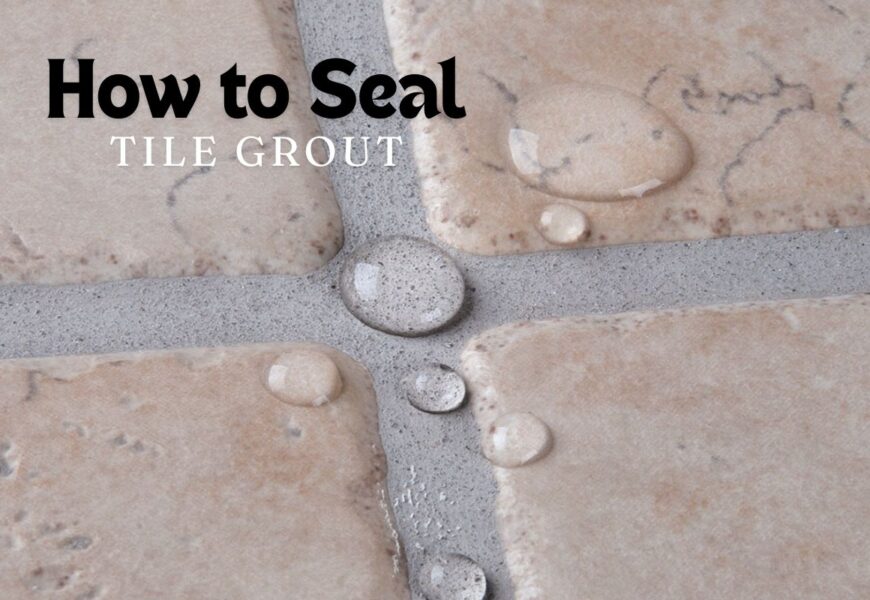Introduction
Keeping your tiled surfaces clean and protected starts with properly sealing the grout. Over time, grout can become stained, cracked, or damaged from moisture and daily wear, making your tiles look dull and worn. Learning how to seal grout effectively not only preserves its appearance but also extends the life of your floors, walls, and backsplashes. This DIY guide will walk you through everything from choosing the right sealer to step-by-step application and maintenance tips. By the end, you’ll have the confidence to protect your grout and keep your tiles looking fresh and vibrant.
Understanding Tile Grout
Grout is the filler material placed between tiles to hold them in place and create a smooth, finished look. It not only stabilizes tiles but also prevents dirt and debris from getting trapped underneath. However, grout is naturally porous, which means it easily absorbs water, stains, and cleaning chemicals. Over time, this leads to discoloration, cracks, or even mold growth if not properly maintained. Knowing how grout works helps you understand why sealing is essential for long-term tile protection.
Why Sealing Grout Is Important
Grout may seem solid, but its porous nature makes it highly vulnerable to water, stains, and everyday wear. Without a protective layer, spills and moisture can seep in, causing mold, mildew, and permanent discoloration. Learning how to seal grout properly acts as a shield, keeping dirt and liquids on the surface where they can be easily cleaned. It also strengthens the grout, reducing the risk of cracking and chipping over time. In short, sealing preserves both the beauty and durability of your tiled surfaces.
When to Seal Grout
The best time to seal grout is after it has fully cured, usually 48–72 hours after installation, to ensure proper bonding. For older tile surfaces, sealing should be done once the grout is thoroughly cleaned and dried to avoid locking in dirt or stains. In high-traffic areas like kitchens, bathrooms, and entryways, resealing is typically needed every 6–12 months. Low-moisture areas may only require sealing every 1–2 years. Keeping track of these intervals helps maintain strong, stain-resistant grout.
Types of Grout Sealers
Grout sealers come in different formulations, each designed to protect against moisture, stains, and wear in specific ways. Choosing the right type depends on your tile surface, location, and maintenance needs. Some sealers penetrate deep into the grout, while others form a protective layer on the surface. Knowing the differences helps you select the most effective option for your home. Below are the main types of grout sealers:
1.Penetrating Sealer
Absorbs into grout pores to protect from within, ideal for damp areas like bathrooms.
2.Surface/Non-Penetrating Sealer
Creates a barrier on top of the grout, good for decorative tiles.
3.Water-Based Sealer
Eco-friendly and easy to apply, with minimal odor.
4.Solvent-Based Sealer
Provides stronger protection, especially for high-moisture zones.
5.Enhancing Sealer
Darkens grout color slightly while adding a protective finish.
Choosing the Right Sealer for Your Tiles
Not all grout sealers work the same, so selecting the right one is key to long-lasting results. For kitchens and bathrooms, a penetrating sealer is often best since it guards against moisture and stains. Decorative tiles may benefit from a surface sealer that enhances appearance while offering basic protection. If you prefer eco-friendly options, water-based sealers provide good coverage with low odor. Matching the sealer type to your tile and location ensures maximum durability and easier maintenance.
Tools and Materials You’ll Need
Before sealing grout, it’s important to gather all the necessary tools and materials to make the process smooth and efficient. Basic supplies include a grout sealer, an applicator brush or roller, and clean microfiber cloths. You’ll also need a grout cleaner or mild detergent to prep the surface before sealing. Protective gloves and proper ventilation are recommended for safety during application. Having everything ready ensures a faster, cleaner, and more professional-looking finish.
Preparing the Surface
Proper preparation is crucial before applying grout sealer to ensure strong protection and long-lasting results. Start by thoroughly cleaning the grout lines with a grout cleaner or a homemade solution to remove dirt, grease, and stains. Allow the grout to dry completely, as sealing damp grout can trap moisture and cause damage later. Clear the surrounding area of dust and debris to avoid particles sticking to the sealer. A clean, dry surface ensures the sealer bonds effectively and delivers the best finish.
Step-by-Step Guide to Sealing Grout
Sealing grout is a straightforward process when done with the right method and patience. Learning how to seal grout properly ensures long-lasting protection and a clean finish. Begin by cleaning and drying the grout lines thoroughly to prepare the surface. Apply the sealer evenly using a brush, roller, or applicator bottle, making sure it covers all grout joints. After about 10 minutes, wipe off any excess sealer from the tiles to prevent streaks, then apply a second coat and allow the grout to cure fully before regular use.
Sealing Tile Floors vs. Backsplashes and Showers
Different tile areas in your home require slightly different sealing approaches. Tile floors, especially in high-traffic zones, need durable penetrating sealers to withstand constant foot pressure and spills. Backsplashes, on the other hand, face more grease and food splatter, so a surface sealer that’s easy to wipe clean works best. Showers demand moisture-resistant sealers to prevent mold and mildew from forming in grout lines. Adapting your sealing method to each space ensures long-lasting protection and easier upkeep.
How to Test if Your Grout Is Properly Sealed
Testing your grout after sealing is a simple way to confirm whether the job was effective. Lightly sprinkle a few drops of water onto the grout lines and watch how it reacts. If the water beads up on the surface, the sealer is working as intended. If it soaks into the grout and darkens it, another coat of sealer may be needed. Performing this quick test ensures your grout is fully protected from moisture and stains.
Maintaining Sealed Grout
Once your grout is sealed, proper maintenance is key to keeping it in good condition. Clean grout lines regularly with a mild cleaner or a pH-neutral solution to avoid damaging the seal. Avoid harsh chemicals or abrasive tools, as they can wear down the protective layer. In high-use areas, monitor for signs of wear and reseal as needed to maintain protection. Consistent care not only extends the life of the seal but also keeps your tiles looking fresh and bright.
Common Questions About Grout Sealing
Many homeowners wonder what happens if grout is left unsealed, and the answer is that it often becomes stained, cracked, or moldy over time. Another common concern is how long to wait before walking on freshly sealed floors—typically 24 hours for full curing. If grout is old, it can usually be sealed after a deep cleaning, though severely damaged grout may need replacement first. People also ask about the best applicators, with brushes, rollers, and applicator bottles all being effective options. Lastly, it’s important to note that grout sealer is different from tile sealer, as it’s designed specifically for porous grout lines.
Tile and Grout Care Tips for Long-Term Protection
To keep your sealed grout looking its best, adopt a consistent cleaning routine using mild, non-abrasive products. Wipe up spills quickly to prevent staining, especially in kitchens and bathrooms. Placing mats or rugs in high-traffic areas helps reduce wear on grout and tiles. Following proper techniques for how to seal grout and avoiding steam cleaners or acidic solutions will protect the sealant. With consistent care, your grout will stay cleaner, stronger, and more resistant to moisture damage.
Also, read: Warm Grey Grout: A Versatile Choice for Your Home
When to Regrout Instead of Reseal
Sometimes sealing isn’t enough, especially if grout is severely cracked, crumbling, or permanently stained. In these cases, regrouting is a better solution to restore both appearance and durability. Regrouting involves removing the old, damaged grout and applying fresh grout between the tiles. This process not only improves the look of your tiled surface but also ensures stronger protection against moisture. Knowing when to regrout instead of reseal saves time and prevents recurring grout problems.
Featured DIY Tools and Products
Using the right tools and products makes grout sealing easier and more effective. Quality applicators and cleaners ensure even coverage and a professional finish. Here are some recommended items for a smooth DIY grout sealing experience:
- Grout Sealer – Choose based on your tile type and location.
- Grout Whitener Pen – Restores the brightness of stained grout before sealing.
- Applicator Brush or Roller – For precise and even application.
- Sealant Remover Tool – Helps correct mistakes or remove old sealer.
- Microfiber Cloths – For wiping off excess sealer and cleaning tiles.
Conclusion
Sealing grout is an essential step in maintaining the beauty and durability of your tiled surfaces. By following proper preparation, selecting the right sealer, and applying it carefully, you can protect your grout from stains, moisture, and everyday wear. Regular maintenance and timely resealing ensure long-lasting results and a cleaner, fresher appearance. Whether for floors, backsplashes, or showers, understanding the process makes the task simple and effective. This guide has covered everything you need to know about how to seal grout for a professional, lasting finish.















